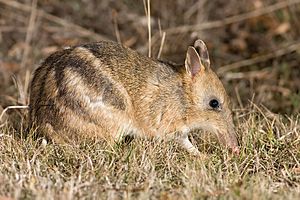Bandicoot facts for kids
Quick facts for kids Bandicoots |
|
|---|---|
 |
|
| Eastern barred bandicoot (Perameles gunni) | |
| Scientific classification |
|
| Kingdom: | Animalia |
| Phylum: | Chordata |
| Class: | Mammalia |
| Infraclass: | Marsupialia |
| Superorder: | Australidelphia |
| Order: | Peramelemorphia |
| Superfamilies, Families, Subfamilies, and Genera | |
|
See text. |
|
Bandicoots are small to medium-sized animals. They are marsupials, which means they carry their babies in a pouch. There are over 20 different kinds of bandicoots. They mostly live on land and are active at night. Bandicoots eat both plants and other animals. You can only find bandicoots in the Australia and New Guinea areas. This includes islands like the Bismarck Archipelago, Seram, and Halmahera.
Contents
What's in a Name?
The word 'bandicoot' comes from a Telugu word, pandikokku. This word means 'pig-rat'. It was first used for large rats in India. These rats are now called bandicoot rats. Even though bandicoots are not found in India, the name stuck. Sometimes, people also use the word "bandicoot" to talk about bilbies, which are related animals.
What Do Bandicoots Look Like?
Bandicoots have a special look. They have V-shaped faces with long, pointed noses. Their noses make them look a bit like elephant shrews. They also have small but strong teeth. These teeth help them chew their food easily.
Bandicoots are good at digging. They have strong snouts and sharp claws. This helps them dig for food in the ground. This digging behavior is called being fossorial.
Bandicoots can be from 28 to 79 centimeters (11 to 31 inches) long. They can weigh from 0.2 to 1.6 kilograms (0.4 to 3.5 pounds). Their bodies are covered in fur. This fur can be brown, black, gold, white, or gray. They have large ears and a long tail. Bandicoots also have strong back legs. These legs are great for jumping!
How Are Bandicoots Grouped?
Scientists group animals to understand them better. Bandicoots belong to a group called Peramelemorphia. This group includes bandicoots and bilbies. For a long time, scientists thought this group was simple. They believed there were two main families: bandicoots and bilbies.
But now, we know it's more complex. Some bandicoots from New Guinea and northern Australia are special. They are different from other bandicoots. Scientists have put them into their own groups. There's even one extinct bandicoot, the Pig-footed bandicoot, that has its own family!
Here's a simpler way to see how bandicoots are grouped:
- Order Peramelemorphia (This is the main group for bandicoots and bilbies)
- Superfamily Perameloidea
- Family Thylacomyidae (This includes the bilbies)
- Genus Macrotis: 2 species (These are the bilbies)
- Family †Chaeropodidae (This family is for the extinct Pig-footed bandicoot)
- Genus †Chaeropus: 1 species
- Family Peramelidae (This is the main bandicoot family)
- Subfamily Peramelinae
- Family Thylacomyidae (This includes the bilbies)
- Superfamily Perameloidea
* Genus Isoodon: These are the short-nosed bandicoots (3 species) * Genus Perameles: These are the long-nosed bandicoots (3 living species)
-
-
-
- Subfamily Peroryctinae
-
-
* Genus Peroryctes: These are the New Guinean long-nosed bandicoots (2 species)
-
-
-
- Subfamily Echymiperinae
-
-
* Genus Echymipera: These are the New Guinean spiny bandicoots (5 species) * Genus Microperoryctes: These are the New Guinean mouse bandicoots (5 species) * Genus Rhynchomeles: This is the Seram bandicoot (1 species)
-
- Superfamily †Yaraloidea (This group is for extinct animals)
- Family †Yaralidae
- Genus †Yarala: 2 species
- Family †Yaralidae
- Superfamily †Yaraloidea (This group is for extinct animals)
Other Names for Bandicoots
Indigenous people in Australia and New Guinea have their own names for bandicoots. For example, the Kaurna people call the southern brown bandicoot bung or marti. These local names show how important these animals are to different cultures.

